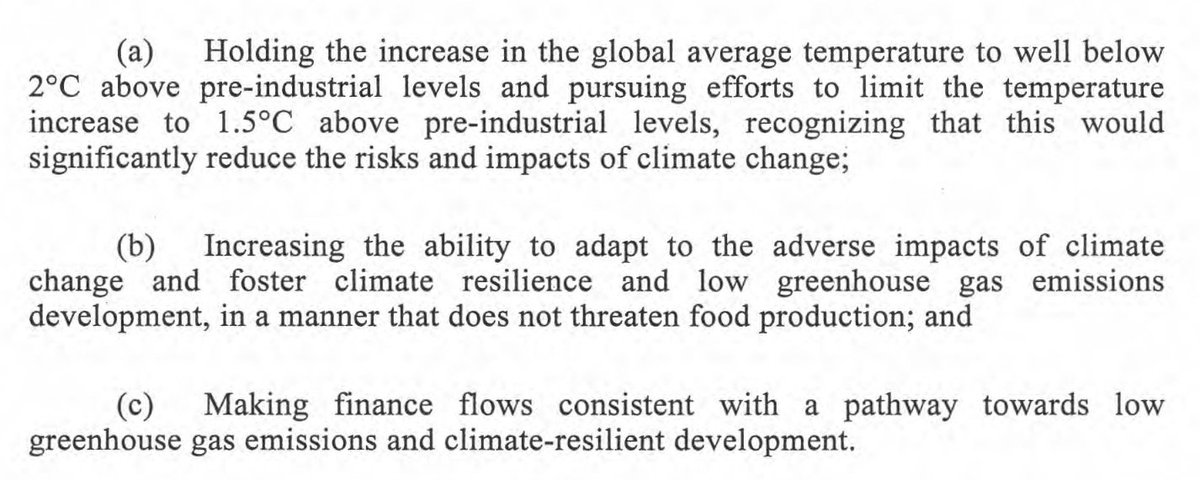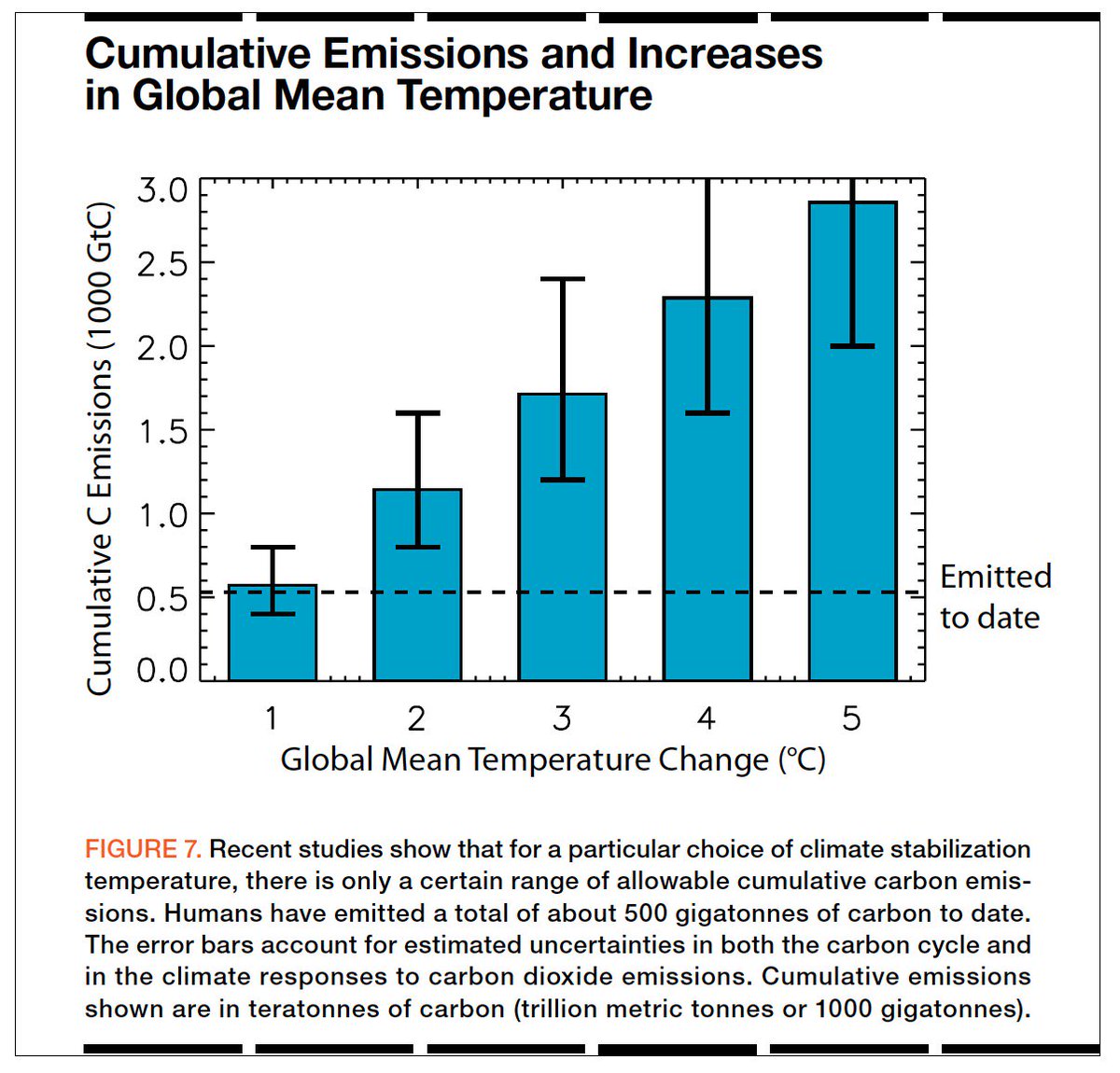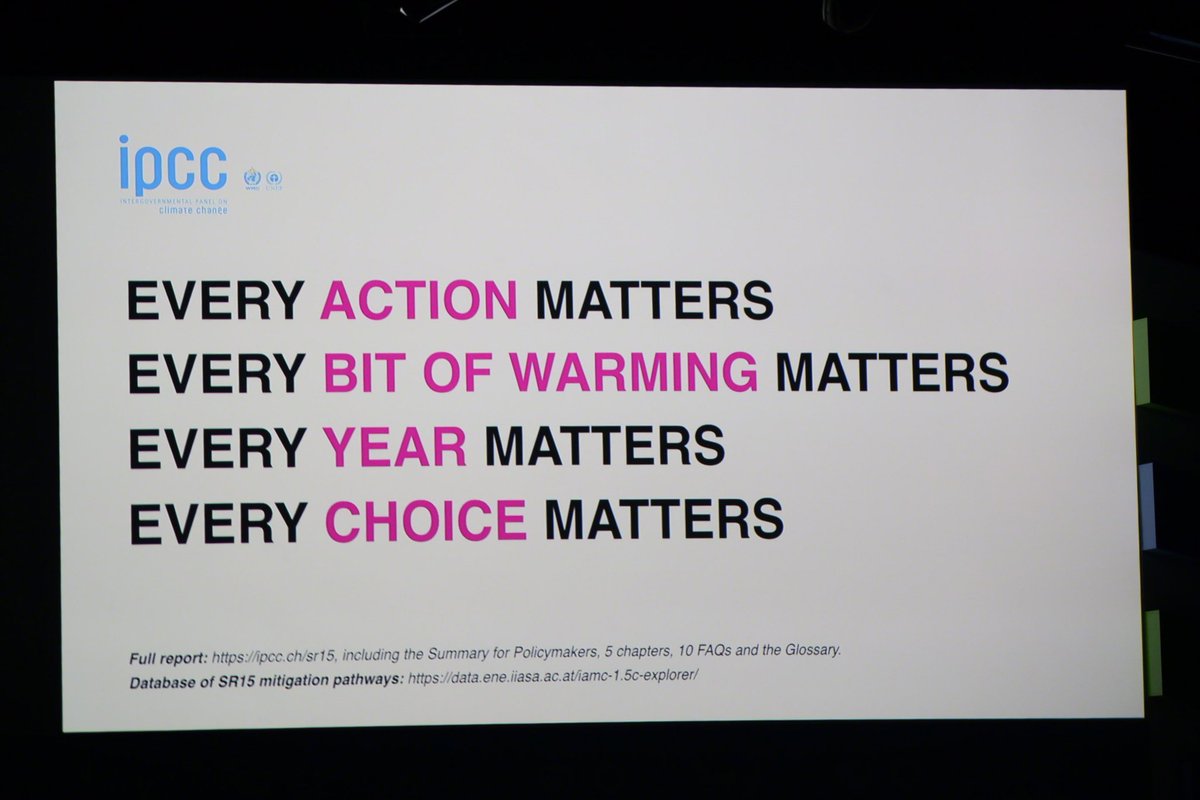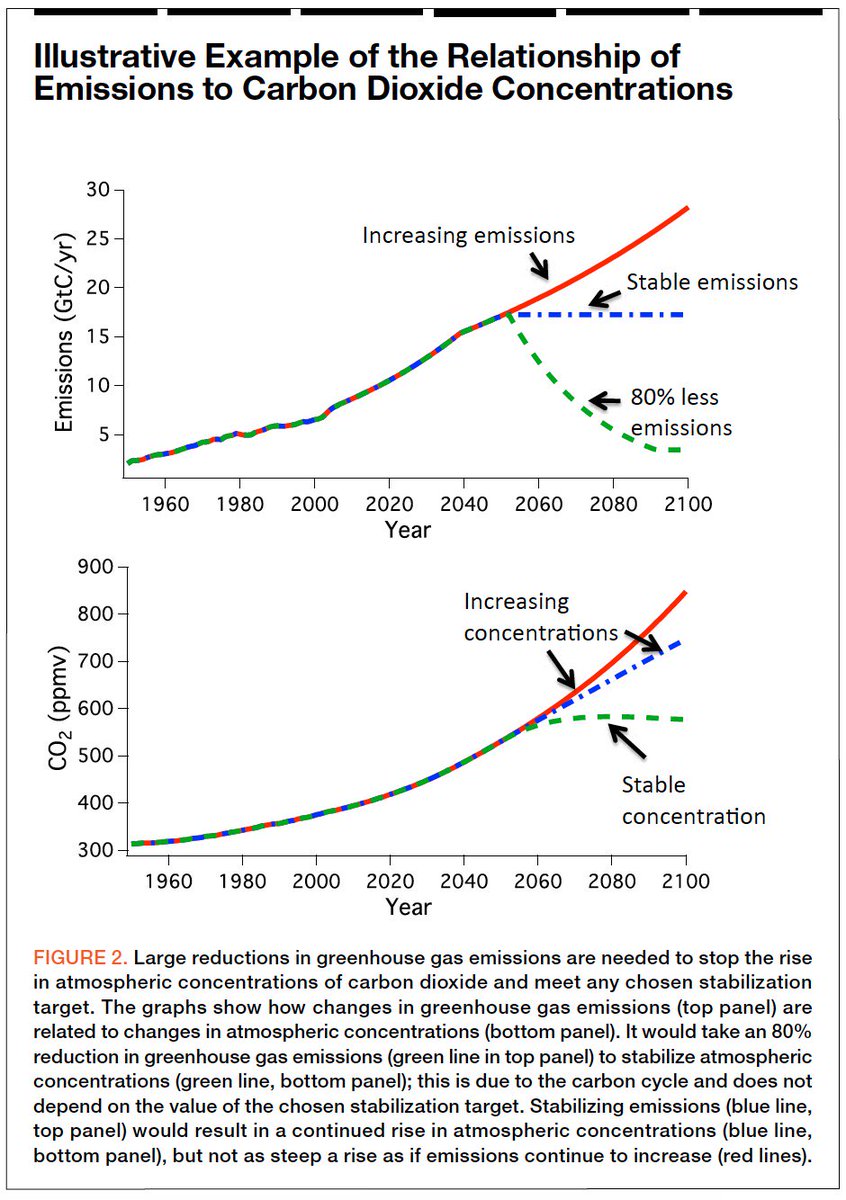When it comes to what climate goals we should be aiming for, there are a lot of "magic numbers" floating around - 2 degrees, 12 years, 350ppm, net zero emissions, and more. Here's a short thread explaining the scientific basis--or lack thereof--for each.
The very first (and still relevant) goal was expressed in the @UNFCCC. It was drafted at the Earth Summit in Rio and adopted in May 1992. It calls for "stabilizing atmospheric CO2 [in ppm] to prevent dangerous human interference with the climate system." Here is the full text:
Since then, there have been 24 "Conference of Parties to the UNFCCC" or COP mtgs. The most recent was in Katowice, Poland. The next is in Santiago, Chile. COPs are not scientific mtgs: they are primarily attended by formal delegations from each nation that's a party to the UNFCCC
(I say this because it's a frequent misconception that COPs are just an excuse for all the climate scientists in the world to regularly gather for expensive and very carbon-intensive parties - haha! In fact, I've only been to one, to provide tech support.)
It took until COP21 - that's right, from 1992 to 2015 - to decide on what might constitute "dangerous interference". That's because "dangerous" is not a scientific definition. It's values-based, and everyone has different values and priorities. Unfortunately, ...
many of the wealthiest and most powerful countries (ahem, companies) in the world view climate solutions as posing a more immediate and short-term threat to their bottom line and well-being than climate impacts. That's a big hurdle to overcome; no wonder it took so long.
Some countries + orgs had already decided what they considered dangerous - the UK initially went for 550ppm, then moved it down to 450ppm; based on Jim Hansen's arguments, orgs like @350 argued for even lower levels. (Note: pre-industrial is ~280ppm). See: https://thinkprogress.org/hansen-et-al-must-read-get-back-to-350-ppm-or-risk-an-ice-free-planet-2b9a29cab989/
Why the disparity? Not because we scientists don't have a good idea of what the impacts will be at 350 (if we could get back there - we are currently above 410!) or 450 or 550ppm CO2 in the atmosphere, but because different people weight mitigation vs adaptation differently.
In the meantime, a lot of research was being done to quantify the impacts of temperature targets: +2, 3, 4oC and beyond. I contributed to the first book on this topic, "Avoiding Dangerous Climate Change," the result of a @DefraGovUK workshop. https://www.amazon.com/Avoiding-Dangerous-Climate-Joachim-Schellnhuber/dp/0521864712/
About a decade of research on food, water, infrastructure, health, energy impacts and more began to converge on ~2oC-ish as preventing "widespread" dangerous impacts (recognizing that locally and regionally they can occur far sooner than a 2oC warming).
By COP21 in Paris, there was a substantial body of research quantifying the impacts of a +2, +3 and beyond warming. This directly informed the expected* goal "to hold global average temperature to well below 2oC". (*see next tweet)
At COP21, however, there was an unexpected surprise: strong support for a more aspirational goal of 1.5oC! Problem: there weren't a lot of studies quantifying impacts under 1.5 versus 2oC. Sol'n: ask @IPCC_CH to write a special report so we knew what the difference was!
The @IPCC_CH 1.5 report was released in Oct 2018. It concluded that there WERE quantifiable differences in many impacts including those related to "health, livelihoods, food security, water supply, human security, and economic growth." See:
It's impt to note that neither 1.5 nor 2oC are magic numbers: i.e., 1.4999oC or 1.9999oC of warming vs 1.5001 or 2.001C does not avoid dangerous impacts everywhere because it's a sliding scale. This Global Weirding episode explains, pls give it a watch!
But regardless of which temperature target we aim for -- which again depends on our priorities (my own research, for example, comparing everything from Iowa corn yields to TX water supply suggests that 1.5oC is typically adaptable, 2oC is challenging, 3oC is system-altering) --
The first step is to translate a temperature target into a cumulative carbon target, as this figure by @damon_matthews from the @theNASEM report we co-authored on "Impacts by Degree" shows. Summary report: https://nas-sites.org/americasclimatechoices/more-resources-on-climate-change/booklet-warming-world-impacts-by-degree/
The second step is to allocate the remaining C budget for a given warming amt by country; but how do we do that? Per capita? By current ems? Historical ems? Future ems? The Paris Agreement solved this by opting for a "potluck dinner" approach. Read: https://blog.ucsusa.org/science-blogger/at-cop21-who-brings-what-to-the-global-potluck
Globally, a number of pathways lead to a cumulative carbon budget consistent with a 1.5 and/or 2oC warming. The IPCC 1.5 report lays these out, and concludes that, broadly, C ems have to decline 45% by 2030 to meet 1.5oC. See:
 and here, my friends, is where the mythical "we have 12 years to fix this or the world ends" narrative comes from. (I'm not pointing my finger at anyone in particular here; I'm just saying I've heard this. A lot.)
and here, my friends, is where the mythical "we have 12 years to fix this or the world ends" narrative comes from. (I'm not pointing my finger at anyone in particular here; I'm just saying I've heard this. A lot.)
Concl'n: Science does not identify a specific goal, target, or timeline. What it says is simply this: the more carbon we produce, the worse the impacts. The best thing to do is wean ourselves off it, as soon as is humanly possible. As a human I'd add: while minimizing suffering.
And that is why, as a scientist and a human, I am fully in support of any policy that cuts heat-trapping gas emissions, as soon as possible, while helping the poor and vulnerable already disproportionately suffering its impacts. As the @IPCC_CH says:
Net zero emissions are the end goal, because that is the ONLY way to stabilize atmospheric concentrations as per the original UNFCCC (1992). How fast we reach net zero determines how much warming we see. This fig from the NASEM (2011) report explains:
And then net *negative* emissions are the ultimate goal, as that is the only way we can bring atmospheric CO2 back down (e.g. to 400 or 350ppm) and reverse some (not all) of the impacts. This is called an "overshoot" pathway. The faster we do this, the more impacts we can avoid.
But the bottom line is this: it's true some impacts are already here. Others are unavoidable. But my research, and that of hundreds of other scientists, clearly shows that our choices matter. It is not too late to avoid the worst impacts. And that's why... https://www.ted.com/talks/katharine_hayhoe_the_most_important_thing_you_can_do_to_fight_climate_change_talk_about_it
REFERENCES
UNFCCC (1992) https://unfccc.int/resource/docs/convkp/conveng.pdf
Paris Agreement (2015) https://unfccc.int/sites/default/files/english_paris_agreement.pdf
NASEM report "warming by degrees" (2011) https://nas-sites.org/americasclimatechoices/more-resources-on-climate-change/booklet-warming-world-impacts-by-degree/
"Avoiding Dangerous Climate Change" (2006) https://www.amazon.com/Avoiding-Dangerous-Climate-Joachim-Schellnhuber/dp/0521864712/
IPCC 1.5 Report (2018) https://www.ipcc.ch/site/assets/uploads/sites/2/2018/07/SR15_SPM_version_stand_alone_LR.pdf
UNFCCC (1992) https://unfccc.int/resource/docs/convkp/conveng.pdf
Paris Agreement (2015) https://unfccc.int/sites/default/files/english_paris_agreement.pdf
NASEM report "warming by degrees" (2011) https://nas-sites.org/americasclimatechoices/more-resources-on-climate-change/booklet-warming-world-impacts-by-degree/
"Avoiding Dangerous Climate Change" (2006) https://www.amazon.com/Avoiding-Dangerous-Climate-Joachim-Schellnhuber/dp/0521864712/
IPCC 1.5 Report (2018) https://www.ipcc.ch/site/assets/uploads/sites/2/2018/07/SR15_SPM_version_stand_alone_LR.pdf
This provides a helpful and relevant perspective ... https://twitter.com/VariabilityBlog/status/1104854583430520834

 Read on Twitter
Read on Twitter![The very first (and still relevant) goal was expressed in the @UNFCCC. It was drafted at the Earth Summit in Rio and adopted in May 1992. It calls for "stabilizing atmospheric CO2 [in ppm] to prevent dangerous human interference with the climate system." Here is the full text: The very first (and still relevant) goal was expressed in the @UNFCCC. It was drafted at the Earth Summit in Rio and adopted in May 1992. It calls for "stabilizing atmospheric CO2 [in ppm] to prevent dangerous human interference with the climate system." Here is the full text:](https://pbs.twimg.com/media/D1Uoh0xWwAASqfZ.jpg)








